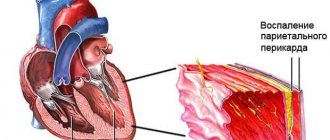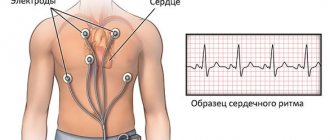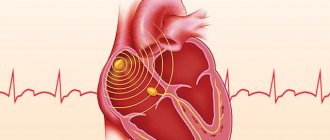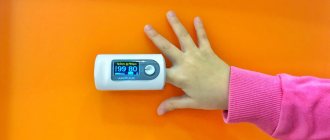Snezhana Shabanova
February 29, 2012
Heart rate (HR), often called “pulse,” shows how many times per minute the heart beats. This rate varies depending on what the person is doing. During sleep, your heart rate is significantly lower than during running. Despite the fact that heart rate and pulse are expressed in the same numbers, there is a technical difference between these two indicators. Heart rate
- This is an indicator of how many heartbeats occur in a certain period of time, usually per minute.
The pulse
is an indicator of the movement of blood through the arteries. By placing your finger on a large artery, you can feel the heart pumping blood. Doctors use heart rate to monitor a person's health. And people involved in sports - to determine the effectiveness of training.
What is called pulse
When the heart muscles contract, the walls of the blood vessels vibrate in a certain rhythm and with a certain force.
These fluctuations are called the pulse, an indicator of the work of the heart and the condition of the blood vessels. Normally, there should be equal intervals between pulsations. Among the causes of disturbances in the rhythm of oscillations of the vascular walls:
- heart pathology
- problems with blood vessels
- endocrine system diseases
- intoxication
- tachycardia of a heavy smoker
- heavy physical activity
- trauma with blood loss
- acute cold
- severe stress, etc.
Any disturbance in heart contractions signals that something is wrong in the body. You should definitely consult a doctor. But first of all, learn how to measure your pulse correctly.
Pulse is an indicator of the work of the heart and blood vessels.
Screening and diagnosis of arrhythmia
To diagnose arrhythmias, the doctor usually asks the patient if they have any heart disease and/or thyroid problems. In addition, specific types of medical testing are always performed to detect arrhythmia. This may be a short or long-term passive recording of an electrocardiogram (a day or more), or an attempt to provoke an arrhythmia while simultaneously continuously recording the heart rhythm.
Passive monitoring methods include:
- Electrocardiography (ECG). During an ECG, electrodes attached to specific locations on the arms, legs, and chest record the electrical activity of the heart. An electrocardiogram examines the intervals and duration of each phase of heart contraction.
- Daily ECG monitoring using the Holter method. A portable ECG recorder is installed for a day or more to record the electrical activity of the heart as a person performs his usual daily activities, as well as during sleep.
- Echocardiography. Allows you to use an ultrasound sensor to obtain an image of the chambers of the heart, clarify their sizes, the movement of the walls and valves and other information.
Arrhythmia can be induced using the following tests:
- Tests with physical activity . Some arrhythmias are triggered or worsened by exercise. During the “stress” test, a treadmill or stationary exercise bike is used. During the test, a continuous ECG recording is made. To perform a “stress” test, medications can be used that stimulate the heart in a similar way to physical exercise. Typically, this method is used when it is impossible to perform physical exercise, as well as to establish a diagnosis of coronary heart disease.
- Tilt table test . When a person has unexplained loss of consciousness, slant tests may be helpful. In this case, rhythm and blood pressure are monitored in a horizontal position for 20-30 minutes. Then a special table is moved to a vertical position and rhythm and blood pressure are also monitored for 10 minutes. In this way, the condition of the heart and the specialized nervous system that controls the functioning of the heart when changing body position and moving from a horizontal to a vertical position is assessed.
- Electrophysiological study and mapping . This study is carried out using the thinnest catheters - electrodes, which are carried into the heart cavity. When electrodes are installed in the area of certain areas of the conduction system of the heart, they can be used to study the propagation of an electrical impulse throughout the heart, induce arrhythmia, while studying its localization and mechanism, and also test the therapeutic effect of various medications. This is the most informative and accurate method for diagnosing most arrhythmias. In addition, when performing EPI, it is possible not only to identify, but also to eliminate the arrhythmogenic focus using a special thermal effect called radiofrequency. In this way, most supraventricular and some types of ventricular tachycardias are eliminated. Currently, this method is also used for atrial fibrillation.
How to measure your pulse manually
- The subject of measurement is the number of pulsations per minute, at rest. For more accurate calculations, use a stopwatch.
- Manual pulse measurements are usually taken from the inside of the wrists of the left and right hands, more precisely, in the area of the radial artery, close to the skin - at the base of the thumb.
- With rhythmic pulsations, you can count how many beats (oscillations of the vascular walls) there were in 30 seconds and double the result.
- For non-rhythmic pulsations, it is recommended to count the beats for a minute.
- In some cases, it is possible to measure the pulse in the area of other arteries located close to the skin on the neck (posterior edge of the sternocleidomastoid muscle), temple, thigh, elbow, under the collarbone, in the groin at the edge of the pubis.
Maximum heart rate
This is the highest number of beats per minute that the heart can make. This indicator is used by athletes to know what maximum load the heart can be subjected to.
It is best to determine the maximum heart rate clinically, that is, this should be done by a cardiologist using a treadmill and an electrocardiograph.
There is another simplified way to find out the capabilities of your heart, but the result will be approximate. Maximum heart rate is determined by the formula:
- for men – 220 minus age;
- for women – 226 minus age.
Pulse measurement with a tonometer
You can conveniently and quickly measure fluctuations in the vascular walls using a special electronic tonometer, which displays blood pressure and pulse indicators on the screen. Depending on the type of model, it can be worn on the wrist or shoulder.
For an untrained adult, a normal heart rate is considered to be between 60 and 80 beats per minute.
It is necessary to strictly follow the instructions for the device. Regardless of the type of tonometer, when measuring your pulse, follow the following important rules:
- do calculations at rest, being relaxed
- take a sitting position
- empty your bladder beforehand
- an hour before measurement, do not consume caffeine, alcohol, or nicotine
- keep your elbow approximately at heart level
- If you want to measure your pulse again, do so after at least 5 minutes.
Remember that when a serious illness is detected, the doctor will not limit himself to simply counting the pulse and recommends more in-depth examinations, for example, undergoing an electrocardiography procedure or doing a so-called treadmill test, that is, a study of the functioning of the heart and blood vessels on a treadmill.
A tonometer will help you accurately determine your heart rate.
How does heart rate differ from pulse?
As already mentioned, heart rate shows how many contractions the heart makes, namely its lower parts - the ventricles - per minute.
The pulse, or heart rate, is the number of times the artery dilates as the heart pumps blood per minute. Blood passing through the vessels during the contraction of the heart creates a bulge in the arteries, which is determined by touch.
The pulse value and heart rate can indeed be equal, but not always, but only in healthy people.
For example, with rhythm disturbances, the heart contracts erratically. If it contracts twice in a row, then the left ventricle does not have time to fill with blood. Thus, the second contraction occurs when the ventricle is empty and no blood is ejected from it into the aorta and peripheral vessels. Therefore, the pulse in the arteries will not be heard while the heart is contracting. With atrial fibrillation and some other diseases, the heart rate does not correspond to the pulse rate. This phenomenon is called pulse deficiency. In such cases, heart rate cannot be determined by measuring the pulse. This can only be done by listening to the heartbeat, for example using a phonendoscope.
In pulse deficiency, the heart rate is greater than the pulse. This usually happens with atrial fibrillation and extrasystole
Normal heart rate in adults and children
Heart rate can depend not only on diseases, but also on many other factors. In particular, on gender and age, body weight and temperature, diet and even the environment. For example, people who are professionally involved in sports have a faster heart rate than untrained people; The pulse quickens in the afternoon and slows down at night.
In order for anyone to determine whether their pulse is normal, they should first take into account their age.
The norm for children is:
- in newborns - from 110 to 160 beats per minute
- in infants from 1 month to 1 year – from 100 to 150
- children from 3 to 8 years old – from 70 to 125
- children from 9 to 11 years old – from 60 to 100
- teenagers from 12 to 15 years old – from 55 to 95
in adults:
- up to 50 years – from 64 to 84
- up to 60 years – from 64 to 84
- after 60 – from 69 to 89
Live broadcast: “Pulse. What should it be like for a healthy person?”
Arterial pulse is one of the important indicators of the functioning of our cardiovascular system and the human body as a whole.
Pulse (pulsus, Latin “beat”) is the oscillatory movement of the walls of the arteries, which occurs depending on the contractions of the heart and the elasticity of the walls of the vessels. In other words, when the heart muscle contracts during systole, blood from the heart chamber is released into the arterial bed, this leads to an increase in pressure in the arteries and their expansion. During the relaxation of the heart muscle, in diastole, the pressure in the arteries decreases. We can evaluate the vibrations of the vessel wall that arise by palpating (feeling) the arteries located shallowly under the skin.
The pulse can be assessed in the carotid, radial, brachial, femoral, popliteal arteries, and arteries of the feet. Examination of the pulse by a doctor includes determination of a number of characteristics, such as frequency, rhythm, filling, tension, amplitude, duration of the systolic wave, etc.
The most common and convenient way to independently assess the pulse is to determine it on the radial artery, on the inside of the wrist on the side of the thumb.
How to determine heart rate?
Pulse rate/heart rate is calculated as the number of beats/contractions in one minute, 60 seconds. In some cases, with severe irregularity (arrhythmia) of the pulse, the frequency is counted for 3 minutes, followed by dividing the result by 3 to determine the average value.
Currently, there are a large number of modern technical means that allow almost every person to determine, without extra effort and without the participation of a specialist, the frequency and rhythm of the pulse at rest and during physical activity: heart rate monitors built into sports watches, trackers, mobile phones. A scale for determining pulse rate and its regularity is also found in most modern automatic devices for determining blood pressure (tonometers).
How accurate are heart rate measurements using sports watches and heart rate monitors?
Most modern devices use the method of optical plethysmography (photoplethysmography). The method is based on the ability of blood to reflect red light and absorb green light. The optical sensor on the back of the watch emits light onto the wrist using LEDs, and measures the amount of light scattered by the bloodstream, thus determining the blood flow on the wrist.
It is believed that optical sensors accurately determine the pulse, incl. when walking and running. However, measurements may become less accurate when your heart rate is very high, above 150 beats per minute, in cold weather (due to decreased blood flow to the wrist). There are other situations that can interfere with the sensor’s operation and lead to errors in heart rate measurement: having a tattoo on the wrist, the watch not fitting tightly to the skin, working out at the gym. Rhythmic movements, such as running or cycling, provide more accurate results compared to tennis or boxing, where athletes move irregularly.
Is it possible to detect heart rhythm disturbances using modern smartwatches and fitness bracelets?
Modern “smart watches” equipped with an ECG recording function allow not only to track the heart rate and give an idea of its rhythm, but can also detect some heart rhythm disturbances. In particular, Apple and AliveCor devices with ECG measurement support are certified to detect heart rhythm disorders such as atrial fibrillation. However, smartwatches are not designed to detect all irregular heart rhythms and cannot be relied upon entirely. They may miss serious problems or cause people to worry unnecessarily about possible heart problems due to so-called “false positives.” In any case, only an examination by a specialist - a cardiologist - can accurately determine the presence of heart rhythm disturbances and their nature. If the watch goes off repeatedly or, more seriously, the person feels unwell, it is imperative to consult a cardiologist. At the EXPERT clinic, an examination is carried out to study the functioning of the heart (24-hour monitoring of ECG and blood pressure, echocardiography), based on the results of which a specialist will give an opinion and recommendations.
Are the pulse rate and heart rate always the same?
In a healthy person, the pulse rate and heart rate are the same, which means that each contraction of the heart results in sufficient blood flow into the arterial system. However, in some pathological conditions, the pulse rate and heart rate may differ; the pulse rate may become less than the heart rate. In this case, it is necessary to contact a specialist and conduct a comprehensive medical examination.
What is a normal resting heart rate/pulse rate?
Resting heart rate/pulse rate depends on many factors, such as age, gender, body weight, average daily sleep duration, smoking, consumption of caffeinated drinks, and level of physical activity. Your heart rate may be affected by certain medications.
In children, normal heart rate values differ from those in adults and significantly depend on age, so in a child of 1-3 months, the heart rate is normally 145-170 beats/min, in 3-6 months - 130-150 beats/min, and at 6-12 months - 120-140 beats/min.
As you get older, your heart rate decreases and the average adult (over 18 years old) should be 60-90 beats per minute at rest. Women's resting heart rate is on average 6-10 beats per minute higher than men's.
A frequent pulse, more than 90 beats/min, is called tachycardia, a rare pulse, less than 60 beats/min, is called bradycardia.
It should be noted that the heart rate at rest in a healthy person is variable and can normally fluctuate over time (day, week, month, year) in a fairly wide range, often going beyond the values accepted as the norm, as well as beyond the framework of the “individual norm”. The heart rate slows down at night, during sleep, and the rate increases after eating. During the day, heart rate gives two rises - the first at about 11 o'clock in the afternoon, the second between 6 and 8 o'clock in the evening. Heart rate can also change with a sharp change in body position or with psycho-emotional stress. Heart rate also has slight seasonal fluctuations; in winter, heart rate is on average higher than in summer.
For trained people who are actively involved in “aerobic”, cyclic endurance sports (skiing, swimming, marathon, cycling, etc.), the resting heart rate is on average lower than that of an untrained person. A pulse of 50-55 beats per minute at rest, and sometimes 40-50 beats per minute, is considered normal for this category of adults and is not accompanied by any unpleasant sensations. In an untrained person, such a heart rate is regarded as bradycardia and requires additional examination by a cardiologist.
Alarming symptoms with a low pulse are weakness, dizziness, fainting, and presyncope. The appearance of these symptoms requires immediate contact with a specialist.
What is the normal heart rate during sleep?
In a healthy person, the heart rate during sleep is lower than during wakefulness. This is explained by the predominance of the tone of the parasympathetic nervous system during sleep. In a healthy adult, the average heart rate during sleep is approximately 18-20 beats/min less than the average daytime heart rate. At the same time, the established average values of heart rate during sleep and wakefulness differ depending on gender and age.
The pulse rate during sleep in a healthy adult can vary as well as during wakefulness, because... sleep is a heterogeneous, dynamic and complexly organized process, consisting of 5 stages (phases) varying in depth. The duration of these stages varies from person to person and is influenced by many factors, both internal and external. This may affect heart rate fluctuations during sleep. The first 4 phases, the phases of slow-wave sleep, are characterized by a gradual decrease in heart rate. During stage five, REM sleep, when you dream, your breathing rate and heart rate may increase. In addition, psycho-emotional or physical stress before bedtime, stress, drinking strong tea or coffee, smoking, drinking alcohol, and a number of medications can cause an increase in heart rate at night.
If attacks of rapid heartbeat during sleep occur regularly without connection with external provoking factors, are accompanied by awakening, a feeling of shortness of breath, discomfort, heaviness or pain in the chest, behind the sternum, it is necessary to undergo an examination to exclude heart disease, endocrine disorders (hyperthyroidism, diabetes mellitus) , inflammatory diseases, anemia, increased blood pressure during sleep and sleep-disordered breathing. The entire range of activities and consultations of specialists involved in the problem can be completed in our clinic.
Pulse rhythm.
A healthy person has a rhythmic pulse, that is, pulse waves follow one another at regular intervals. In case of heart rhythm disturbances (arrhythmias), pulse waves usually follow at irregular intervals and the pulse becomes arrhythmic. In some cases, arrhythmia may be accompanied by a feeling of discomfort in the heart area, difficulty breathing, a feeling of “somersaults”, blows to the chest, dizziness and even loss of consciousness. In this situation, it is advisable to contact a cardiologist to clarify the nature of heart rhythm disturbances and exclude cardiac pathology.
What is the normal heart rate during exercise?
Currently, much attention is paid to regular physical exercise to prevent the development of cardiovascular diseases, as well as as part of comprehensive cardiac rehabilitation. The benefits of regular physical activity have been proven in large scientific studies. It is very important that the recommended physical activity is safe for humans. Intense, inadequate physical activity in untrained people can lead to the development of various complications.
The optimal level of physical activity is determined individually and depends on the functionality of the cardiovascular and respiratory systems, age, and characteristics of physical development. For proper planning of the intensity of physical activity, one of the main criteria is determining the heart rate. The intensity of physical activity is expressed as a percentage of the maximum heart rate. In this case, the maximum heart rate is the highest pulse frequency at which normal heart function is maintained.
There are many formulas for calculating your maximum heart rate. Traditionally, the formula is used: HRmax = 220 – “Age”.
However, it must be taken into account that the formulas calculate statistically averaged values, while individual values of maximum heart rate depend not only on age or gender. As already mentioned, the maximum heart rate is also influenced by the degree of training and anthropometric indicators.
When performing physical exercises, there are five levels of training intensity or pulse zones:
- moderate exercise (pulse 50–60% of maximum heart rate);
- “weight control” (pulse 60–70% of maximum heart rate);
- aerobic zone (pulse 70–80% of maximum heart rate);
- anaerobic training (pulse 80–90% of maximum heart rate);
- maximum load (pulse 90–100% of maximum heart rate).
To calculate your maximum heart rate during training, you can use the Karvonen Formula:
Heart rate during exercise = (maximum heart rate - resting heart rate) x intensity (in percent) + resting heart rate
The moderate-intensity zone is best suited for those who are either just starting their training or have a low level of general physical fitness. The initial level of physical activity in untrained people should not cause an increase in heart rate of more than 30 beats per minute compared to the resting state. The level of exercise should be increased gradually over 1-3 weeks depending on tolerance. Training in the anaerobic zone and in the maximum load zone is suitable for well-trained individuals and professional athletes.
It is important to remember that before starting training, it is necessary to undergo a comprehensive medical examination, which allows, first of all, to exclude diseases of the cardiovascular system, assess the functionality of the heart and respiratory system, and also determine the individual maximum heart rate.
You need to know that when performing physical activity, the appearance of such symptoms as: discomfort, unpleasant sensations, pain behind the sternum or in the left half of the chest, weakness, fatigue, headache, dizziness, interruptions in heart function, severe sweating; - is a sign of inadequate physical activity and may be a manifestation of pathology of the cardiovascular system. In this case, it is necessary to immediately contact a cardiologist.
You can more accurately determine your heart rate and the presence of heart rhythm disturbances (arrhythmias) using electrocardiography. If it is necessary to assess heart rate at different times of the day and under different loads, 24-hour electrocardiogram monitoring is performed. To assess the response of the cardiovascular system to stress and determine the individual maximum heart rate, tests are carried out with dosed physical activity. It is important to remember that only a specialist can determine the need and scope of examinations.
Slow and fast heartbeat
The heart muscle can contract at an increased (tachycardia) or decreased (bradycardia) rhythm. If the pulse does not correspond to the norm, there is no need to immediately sound the alarm: the reason may be not only in pathology, but also in the physiology of the female or male body. Thus, some increase in heart rate is observed when women reach menopause, or when estrogen levels decrease; slowing of the pulse - when taking certain medications.
Various physical and mental stress affect the heart rate, even the difficult digestion process after a heavy holiday dinner and the use of energy drinks. Typically, physiological causes of abnormal heart rate are temporary. After 45 minutes, the pulse readings can return to normal.
Record your heart rate readings on both hands - this will allow you to get more accurate data when measuring this indicator manually.
Clinical practice shows that the pulse often increases when the nervous system is damaged, cardiac pathology, or hormonal system disorders. It is possible that with high readings a tumor or some kind of infection develops in the body.
The pulse slows down if the body experiences intoxication, peptic ulcer disease, or increased intracranial pressure, myocardial infarction develops. Perhaps this signals a lack of thyroid hormones, organic damage to the heart, or poor oxygen supply to tissues.
Only a specialist can answer the question why your pulse is too fast or too rare. In any case, consult a doctor immediately if your pulse is abnormal:
- dyspnea
- my head is spinning
- fainting or presyncope
- heart pain
- vision problems
When playing sports, it is important to regularly measure your pulse.
Causes of tachycardia and bradycardia
If your heart rate at rest is not normal, this may be a sign of illness. Usually, other manifestations of the disease are also present.
If tachycardia is accompanied by symptoms such as dizziness, shortness of breath, weakness, fainting, then the following cannot be ruled out:
- infectious disease;
- heart disease;
- onset of stroke;
- endocrine disorders;
- diseases of the nervous system;
- tumor processes;
- anemia.
Bradycardia can normally be observed in the following cases:
- for athletes (40 strokes);
- in people engaged in heavy physical labor;
- when taking certain medications.
It can also be a sign of illness:
- poisoning;
- heart attack;
- stomach ulcers;
- hypothyroidism;
- myocardial inflammation.











